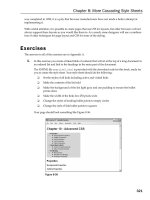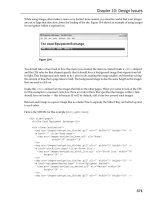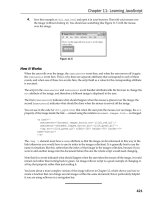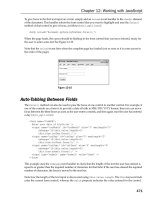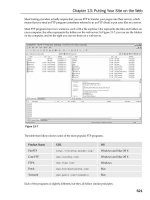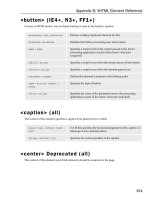Web Programming with JavaJava Server PagesHuynh Huu Viet University of Information Technology docx
Bạn đang xem bản rút gọn của tài liệu. Xem và tải ngay bản đầy đủ của tài liệu tại đây (2.19 MB, 106 trang )
1
Web Programming with Java
Java Server Pages
Huynh Huu Viet
University of Information Technology
Department of Information Systems
Email:
2008 © Department of Information Systems - University of Information Technology
2
Outline
Introduction
Scripting Elements
The JSP page Directive
Including Files
Using JavaBeans Components in JSP
Servlets and JSP: The Model View
Controller (MVC) Architecture
2008 © Department of Information Systems - University of Information Technology
3
The Need for JSP
With servlets, it is easy to
Read form data
Read HTTP request headers
Set HTTP status codes and response headers
Use cookies and session tracking
Share data among servlets
Remember data between requests
Get fun, high-paying jobs
But, it sure is a pain to
Use those println statements to generate HTML
Maintain that HTML
2008 © Department of Information Systems - University of Information Technology
4
JSP Framework
Idea:
Use regular HTML for most of page
Mark servlet code with special tags
Entire JSP page gets translated into a servlet (once), and servlet
is what actually gets invoked (for each request)
Example
2008 © Department of Information Systems - University of Information Technology
5
Benefits of JSP
Although JSP technically can't do anything
servlets can't do, JSP makes it easier to:
Write HTML
Read and maintain the HTML
JSP makes it possible to:
Use standard HTML tools such as Macromedia
DreamWeaver or Adobe GoLive.
Have different members of your team do the HTML
layout than do the Java programming
JSP encourages you to
Separate the (Java) code that creates the content
from the (HTML) code that presents it
2008 © Department of Information Systems - University of Information Technology
6
Advantages of JSP Over Competing Technologies (1)
Versus ASP or ColdFusion
Better language for dynamic part
Portable to multiple servers and operating systems
Versus PHP
Better language for dynamic part
Better tool support
Versus pure servlets
More convenient to create HTML
Can use standard tools (e.g., DreamWeaver)
Divide and conquer
JSP programmers still need to know servlet
programming
2008 © Department of Information Systems - University of Information Technology
7
Advantages of JSP Over Competing Technologies (2)
Versus client-side JavaScript (in browser)
Capabilities mostly do not overlap with JSP, but
• You control server, not client
• Richer language
Versus server-side JavaScript (e.g.,
LiveWire, BroadVision)
Richer language
Versus static HTML
Dynamic features
Adding dynamic features no longer"all or nothing"
decision
2008 © Department of Information Systems - University of Information Technology
8
Example
<HTML>
<HEAD>
<TITLE>JSP Expressions</TITLE>
<META NAME="keywords" CONTENT="JSP,expressions,JavaServer Pages">
<META NAME="description“ CONTENT="A quick example of JSP expressions.">
<LINK REL=STYLESHEET HREF="JSP-Styles.css“ TYPE="text/css">
</HEAD>
<BODY>
<H2>JSP Expressions</H2>
<UL>
<LI>Current time: <%= new java.util.Date() %>
<LI>Server: <%= application.getServerInfo() %>
<LI>Session ID: <%= session.getId() %>
<LI>The <CODE>testParam</CODE> form parameter:
<%= request.getParameter("testParam") %>
</UL>
</BODY>
</HTML>
2008 © Department of Information Systems - University of Information Technology
9
JSP Lifecycle
2008 © Department of Information Systems - University of Information Technology
10
JSP/Servlets in the Real World
Ten most popular
Web sites [1]
1) Google
•Custom
technology,some Java
2) Yahoo
• PHP and Java
3) MySpace
• ColdFusion (Java
“under the hood”)
4) YouTube
• Flash, Python, Java
9) Ebay
•Java
10) AOL
•Java
Web pages using JSP [2]
568 million
Most popular languages
worldwide [3]
Java
C/C++
Visual Basic
PHP
Python
C#
[1]: reported by alexis.com, Fall 2008
[2]:reported by Google
[3]: reported by tiobe.com
2008 © Department of Information Systems - University of Information Technology
11
Some webpages using JSP
Airlines
American Airlines
British Airways
United Airlines
Financial Services
Bank of America
NY Stock Exchange
Royal Bank of
Scotland
Entertainment
Billboard.com
WarnerBrothers.com
Military and Federal
Government
CIA
NSA
Army
Search/Portals
Parts of Google
All of Ebay
Paypal
2008 © Department of Information Systems - University of Information Technology
12
Outline
Introduction
Scripting Elements
The JSP page Directive
Including Files
Using JavaBeans Components in JSP
Servlets and JSP: The Model View
Controller (MVC) Architecture
2008 © Department of Information Systems - University of Information Technology
13
Uses of JSP Constructs
Scripting elements calling servlet
code directly
Scripting elements calling servlet
code indirectly (by means of utility
classes)
Beans
Servlet/JSP combo (MVC)
MVC with JSP expression language
Custom tags
MVC with beans, custom tags, and a
framework like Struts or JSF
Simple
Application
Complex
Application
2008 © Department of Information Systems - University of Information Technology
14
Design Strategy: Limit Java code in JSP Pages
You have two options
Put 25 lines of Java code directly in the JSP page
Put those 25 lines in a separate Java class and put 1
line in the JSP page that invokes it
Why is the second option much better?
Development. You write the separate class in a
Javaenvironment (editor or IDE), not an HTML
environment
Debugging. If you have syntax errors, you see
themimmediately at compile time. Simple print
statements can be seen.
Testing. You can write a test routine with a loop that
does 10,000 tests and reapply it after each change.
Reuse. You can use the same class from multiple
pages.
2008 © Department of Information Systems - University of Information Technology
15
Basic Syntax
HTML Text
<H1>Blah</H1>
Passed through to client. Really turned into servlet
code that looks like
• out.print("<H1>Blah</H1>");
HTML Comments
<! Comment >
Same as other HTML: passed through to client
JSP Comments
<% Comment %>
Not sent to client
Escaping <%
To get <% in output, use <\%
2008 © Department of Information Systems - University of Information Technology
16
Scripting Elements
Expressions
Format: <%= expression %>
Evaluated and inserted into the servlet’s output. I.e., results in
something like out.print(expression)
Scriptlets
Format: <% code %>
Inserted verbatim into the servlet’s _jspService method (called
by service)
Declarations
Format: <%! code %>
Inserted verbatim into the body of the servlet class, outside of
any existing methods
XML syntax
See slides at end of the lecture for an XML-compatible way of
representing JSP pages and scripting elements
2008 © Department of Information Systems - University of Information Technology
17
JSP Expressions
Format
<%=Java Expression %>
Result
Expression evaluated, converted to String, and placed into
HTML page at the place it occurred in JSP page
That is, expression placed in _jspService inside out.print
Examples
Current time: <%= new java.util.Date() %>
Your hostname: <%= request.getRemoteHost() %>
XML-compatible syntax
<jsp:expression> Java Expression</jsp:expression>
You cannot mix versions within a single page You must page.
use XML for entire page if you use jsp:expression.
• See slides at end of this lecture
2008 © Department of Information Systems - University of Information Technology
18
JSP/Servlet Correspondence
Original JSP
<H1>A Random Number</H1>
<%= Math.random() %>
Representative resulting servlet code
public void _jspService(HttpServletRequest request,
HttpServletResponse
response)
throws ServletException, IOException {
response.setContentType("text/html");
HttpSession session = request.getSession();
JspWriter out = response.getWriter();
out.println("<H1>A Random Number</H1>");
out.println(Math.random());
}
2008 © Department of Information Systems - University of Information Technology
19
Predefined Variables
request
The HttpServletRequest (1st argument to
service/doGet)
response
The HttpServletResponse (2nd arg to service/doGet)
out
The Writer (a buffered version of type JspWriter) used
to send output to the client
session
The HttpSession associated with the request (unless
disabled with the session attribute of the page
directive)
application
The ServletContext (for sharing data) as obtained via
getServletContext().
2008 © Department of Information Systems - University of Information Technology
20
Comparing Servlets to JSP
<HTML>
<HEAD>
<TITLE>Reading Three Request Parameters</TITLE>
<LINK REL=STYLESHEET
HREF="JSP-Styles.css“
TYPE="text/css">
</HEAD>
<BODY>
<H1>Reading Three Request Parameters</H1>
<UL>
<LI><B>param1</B>:
<%= request.getParameter("param1") %>
<LI><B>param2</B>:
<%= request.getParameter("param2") %>
<LI><B>param3</B>:
<%= request.getParameter("param3") %>
</UL>
</BODY></HTML>
2008 © Department of Information Systems - University of Information Technology
21
JSP Scriptlets
Format
<% Java Code %>
Result
Code is inserted verbatim into servlet's _jspService
Example
<%
String queryData = request.getQueryString();
out.println("Attached GET data: " + queryData);
%>
<% response.setContentType("text/plain"); %>
XML-compatible syntax
<jsp:scriptlet> Java Code</jsp:scriptlet>
2008 © Department of Information Systems - University of Information Technology
22
JSP/Servlet Correspondence
Original JSP
<H2>foo</H2>
<%= bar() %>
<% baz(); %>
Representative resulting servlet code
public void _jspService(HttpServletRequest request,
HttpServletResponse response)
throws ServletException, IOException {
response.setContentType("text/html");
HttpSession session = request.getSession();
JspWriter out = response.getWriter();
out.println("<H2>foo</H2>");
out.println(bar());
baz();
}
2008 © Department of Information Systems - University of Information Technology
23
JSP Scriptlets Example
Suppose you want to let end users
customize the background color of a
page
What is wrong with the following code?
<BODY BGCOLOR=
"<%= request.getParameter("bgColor") %>">
2008 © Department of Information Systems - University of Information Technology
24
JSP Scriptlets Example
<HTML>
<HEAD>
<TITLE>Color Testing</TITLE>
</HEAD>
<%
String bgColor = request.getParameter("bgColor");
if ((bgColor == null)||(bgColor.trim().equals(""))){
bgColor = "WHITE";
}
%>
<BODY BGCOLOR="<%= bgColor %>">
<H2 ALIGN="CENTER">Testing a Background of “
<%= bgColor %>".</H2>
</BODY></HTML>
2008 © Department of Information Systems - University of Information Technology
25
Make Parts of the JSP File Conditional
Point
Scriplets are inserted into servlet exactly as written
Need not be complete Java expressions
Complete expressions are usually clearer and easier to maintain,
however
Example
<% if (Math.random() < 0.5) { %>
Have a <B>nice</B> day!
<% } else { %>
Have a <B>lousy</B> day!
<% } %>
Representative result
if (Math.random() < 0.5) {
out.println("Have a <B>nice</B> day!");
} else {
out.println("Have a <B>lousy</B> day!");
}
